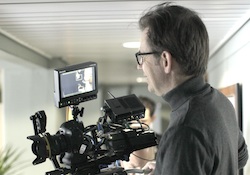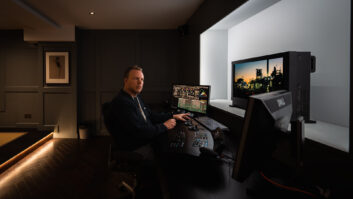
Norway’s TV2 is believed to be the first broadcaster to shoot a complete drama series on a DSLR. The ten-part (23-minute) Dags Univers is a dark comedy about a marriage therapist who wants people to live alone. It is currently shooting in Oslo and is scheduled for prime-time transmission in the autumn. David Fox reports.
Dags Univers is being shot with two Canon 1D Mark IV cameras, which were chosen mainly as a matter of timing. Håvar Karlsen, the B-camera Operator/2nd Unit DoP and Canon DSLR consultant on the series, “had used the 5Ds for some time, and from what I could see the results were quite promising, and when we heard news about the arrival of the 1D Mark IV we got in touch with Canon to be part of an early arrival testing […] taking a calculated risk that the 1D would arrive in time for our production to start,” explains Director of Photography Pål Bugge Haagenrud.
“Shooting under incredible low light levels was an advantage we wanted to take use of, since we are shooting in practical locations.” The lighting has been planned with the option to use venetian blinds to control daylight coming through windows, and includes a few KinoFlos, a Dedolight 400 Par, a Dedolight 400 Octodome, a Dedolight 200 HMI, and 200 Dedo Octodome (with the option to use 200W HMI Tungsten globes and Daylight globes). “In addition we have found great use in a small shiny board with flex fill to bring out the eyes,” he says.
“But we discovered through a hectic week of testing (as we got the cameras one week prior to principal photography) that since we have such a compressed file, we had to light the way we wanted it to look, and with my background from more than 25 years as a cameraman, shooting 16mm reversal as a starter, the allegory was simple: light it like you are shooting good old slides or reversal film.” What you see is (more or less) what you get.
Canon Norway helped out, and supplied a range of prime lenses and three zooms. “We were able to shoot at T1.4, but we have discovered that focus is then so limited that it is hard for our seasoned veteran for more than 25 years as focus puller, Anders Legaard, to be close to hit the focus target on moving objects, but we have managed to nail it on designed shots with fantastic results,” adds Haagenrud.
Having been used to carrying large cameras, such as the Arri BL4S with 1000-foot magazine and a 25-250 zoom, he saw this as “an opportunity of a lifetime to work fast with small and lightweight cameras – grab shots from impossible angles – but at the same time treat the camera as a single camera film camera, with good old Ronford Baker F15S fluid head and solid baby and standard [tripods] and a lightweight dolly.”
Haagenrud loves the size of the camera, which makes it easy to put “in impossible places. Actors love it, but it must be mounted to look like a camera or people won’t take it seriously.”
The option to use 35mm lenses with the shallow depth of field was also a reason to use DSLRs – as was the budget. “I would love to shoot on Red or even Panasonic 3000, but now I’m not so sure. This show, done 65% on controlled locations, with exteriors in the low light period of winter in the Nordic light, harsh contrast is not a problem — so we can easily control the exteriors, and have been blessed with clouds on our exterior days,” says Haagenrud.
Prior to production, they did a week of testing and Legaard decided to take the Red Rock Cinema package and totally strip it down and build it the way he would want a film camera to work. “We tried for a few days puling focus from the lens, but eventually brought in the Scorpio follow focus, and Anders is now pulling focus from a 17-inch TV Logic monitor, and also a great help to control the exposure from his dark tent,” he adds. “Since we are shooting with Canon Primes there is a great challenge to pull focus since the pull is so short on the barrel of the lens.”
They use Black Magic HDMI-to-SDI converters and encounter a few seconds delay from when the HDMI signal leaves the 1D to arriving at the video village (where it is also recorded onto Panasonic AVCAM solid-state recorders) and the on board monitor. “We do also encounter quite a bit of static electricity that make us lose the signal to the onboard monitor, forcing is to turn on/turn off the monitor to get the image – a little bit like rebooting the Red, but still hard to cope with the instability of this problem.”
There was a corrupted file in the first week, “which we do believe can have to do with a long take,” but 39 days into the production that was on the only file problem they had experienced.
Getting the look
They shoot 1080 25p with no HLT (Highlight Tone Priority). Karlsen had read a lot online about HLT: “People were really uncertain about the pros/cons. After all, it’s just a minor tweak in ISO settings to protect highlight. As we shoot mostly indoors, there’s no need to complicate things.” They also use 50p for slow motion work, and have selected a neutral picture style with sharpness, and contrast turned way down.
“The production house we are using are using Avid, so offline is being done there. I think the codec they went for is DNxHD 120, because of faster transcoding times. I did some online tests with some shots in H.264 and DNxHD 120, and after seeing more noise patterns etc. in the 120 version, we decided were going to assemble a H.264 online based on an Avid EDL. The online facility will then use uncompressed HD or DPX to the final master,” explains Karlsen.
In grading, “we’re going to apply noise reduction and sharpening as a general rule. We took off all sharpening in the camera to reduce moiré, and we are adding this in post to get the punch in the focus back,” he added.
“The main battle we are fighting every day with these cameras is rather focus than moiré. Since we have pulled the sharpness down in camera, focus can appear soft if not viewed in a proper full HD monitor. We know we have some moiré issues in certain scenes (background), but once the problem is identified, we always try to open the lens to hide the problem. In post (and especially in an SD master) we also have tools to reduce the issue. It remains to be seen how bad the issue is, but during shooting we haven’t noticed too much,” said Karlsen.
Improvements that Haagenrud would like to see to the 1D are the addition of zebra patterns, colour bar, controlled sound levels (which has recently been added to the 5D), XLR inputs “in the bottom of the 1D”, and lenses with film style focus options.
He advises anyone contemplating using a DSLR to “treat it like a film camera, as much as possible. Light it like reversal film. Enjoy the loss of weight on your shoulder. Grab the frames it used to take hours to rig. Think multicamera.”







